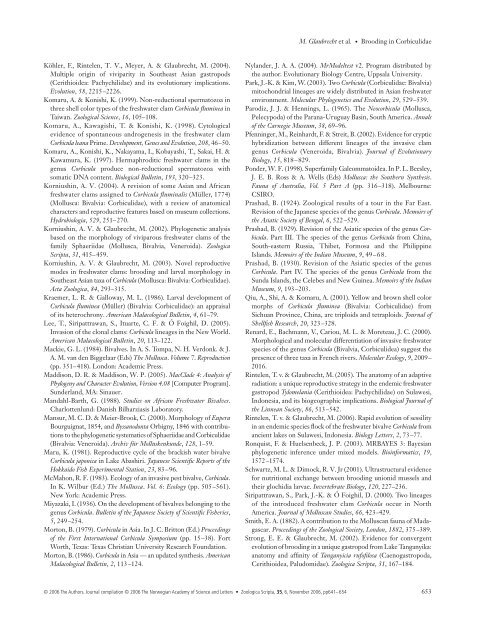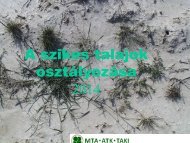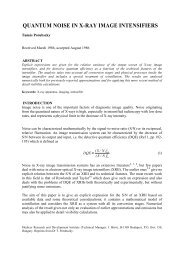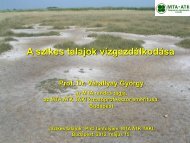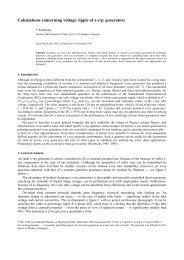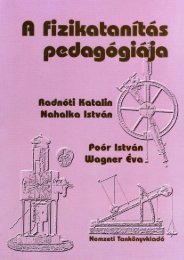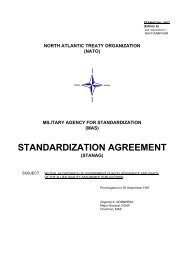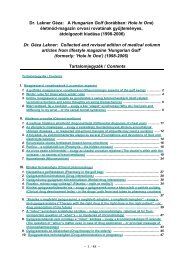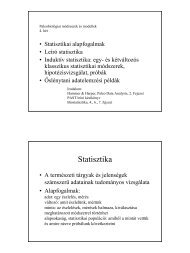Brooding in Corbicula madagascariensis (Bivalvia, Corbiculidae)
Brooding in Corbicula madagascariensis (Bivalvia, Corbiculidae)
Brooding in Corbicula madagascariensis (Bivalvia, Corbiculidae)
- No tags were found...
Create successful ePaper yourself
Turn your PDF publications into a flip-book with our unique Google optimized e-Paper software.
M. Glaubrecht et al. • <strong>Brood<strong>in</strong>g</strong> <strong>in</strong> <strong>Corbiculidae</strong>Köhler, F., R<strong>in</strong>telen, T. V., Meyer, A. & Glaubrecht, M. (2004).Multiple orig<strong>in</strong> of viviparity <strong>in</strong> Southeast Asian gastropods(Cerithioidea: Pachychilidae) and its evolutionary implications.Evolution, 58, 2215–2226.Komaru, A. & Konishi, K. (1999). Non-reductional spermatozoa <strong>in</strong>three shell color types of the freshwater clam <strong>Corbicula</strong> flum<strong>in</strong>ea <strong>in</strong>Taiwan. Zoological Science, 16, 105–108.Komaru, A., Kawagishi, T. & Konishi, K. (1998). Cytologicalevidence of spontaneous androgenesis <strong>in</strong> the freshwater clam<strong>Corbicula</strong> leana Prime. Development, Genes and Evolution, 208, 46–50.Komaru, A., Konishi, K., Nakayama, I., Kobayashi, T., Sakai, H. &Kawamura, K. (1997). Hermaphroditic freshwater clams <strong>in</strong> thegenus <strong>Corbicula</strong> produce non-reductional spermatozoa withsomatic DNA content. Biological Bullet<strong>in</strong>, 193, 320–323.Korniush<strong>in</strong>, A. V. (2004). A revision of some Asian and Africanfreshwater clams assigned to <strong>Corbicula</strong> flum<strong>in</strong>alis (Müller, 1774)(Mollusca: <strong>Bivalvia</strong>: <strong>Corbiculidae</strong>), with a review of anatomicalcharacters and reproductive features based on museum collections.Hydrobiologia, 529, 251–270.Korniush<strong>in</strong>, A. V. & Glaubrecht, M. (2002). Phylogenetic analysisbased on the morphology of viviparous freshwater clams of thefamily Sphaeriidae (Mollusca, <strong>Bivalvia</strong>, Veneroida). ZoologicaScripta, 31, 415–459.Korniush<strong>in</strong>, A. V. & Glaubrecht, M. (2003). Novel reproductivemodes <strong>in</strong> freshwater clams: brood<strong>in</strong>g and larval morphology <strong>in</strong>Southeast Asian taxa of <strong>Corbicula</strong> (Mollusca: <strong>Bivalvia</strong>: <strong>Corbiculidae</strong>).Acta Zoologica, 84, 293–315.Kraemer, L. R. & Galloway, M. L. (1986). Larval development of<strong>Corbicula</strong> flum<strong>in</strong>ea (Müller) (<strong>Bivalvia</strong>: <strong>Corbiculidae</strong>): an appraisalof its heterochrony. American Malacological Bullet<strong>in</strong>, 4, 61–79.Lee, T., Siripattrawan, S., Ituarte, C. F. & Ó Foighil, D. (2005).Invasion of the clonal clams: <strong>Corbicula</strong> l<strong>in</strong>eages <strong>in</strong> the New World.American Malacological Bullet<strong>in</strong>, 20, 113–122.Mackie, G. L. (1984). Bivalves. In A. S. Tompa, N. H. Verdonk. & J.A. M. van den Biggelaar (Eds) The Mollusca. Volume 7. Reproduction(pp. 351–418). London: Academic Press.Maddison, D. R. & Maddison, W. P. (2005). MacClade 4: Analysis ofPhylogeny and Character Evolution, Version 4.08 [Computer Program].Sunderland, MA: S<strong>in</strong>auer.Mandahl-Barth, G. (1988). Studies on African Freshwater Bivalves.Charlottenlund: Danish Bilharziasis Laboratory.Mansur, M. C. D. & Meier-Brook, C. (2000). Morphology of EuperaBourguignat, 1854, and Byssanodonta Orbigny, 1846 with contributionsto the phylogenetic systematics of Sphaeriidae and <strong>Corbiculidae</strong>(<strong>Bivalvia</strong>: Veneroida). Archiv für Molluskenkunde, 128, 1–59.Maru, K. (1981). Reproductive cycle of the brackish water bivalve<strong>Corbicula</strong> japonica <strong>in</strong> Lake Abashiri. Japanese Scientific Reports of theHokkaido Fish Experimental Station, 23, 83–96.McMahon, R. F. (1983). Ecology of an <strong>in</strong>vasive pest bivalve, <strong>Corbicula</strong>.In K. Wilbur (Ed.) The Mollusca. Vol. 6: Ecology (pp. 505–561).New York: Academic Press.Miyazaki, I. (1936). On the development of bivalves belong<strong>in</strong>g to thegenus <strong>Corbicula</strong>. Bullet<strong>in</strong> of the Japanese Society of Scientific Fisheries,5, 249–254.Morton, B. (1979). <strong>Corbicula</strong> <strong>in</strong> Asia. In J. C. Britton (Ed.) Proceed<strong>in</strong>gsof the First International <strong>Corbicula</strong> Symposium (pp. 15–38). FortWorth, Texas: Texas Christian University Research Foundation.Morton, B. (1986). <strong>Corbicula</strong> <strong>in</strong> Asia — an updated synthesis. AmericanMalacological Bullet<strong>in</strong>, 2, 113–124.Nylander, J. A. A. (2004). MrModeltest v2. Program distributed bythe author. Evolutionary Biology Centre, Uppsala University.Park, J.-K. & Kim, W. (2003). Two <strong>Corbicula</strong> (<strong>Corbiculidae</strong>: <strong>Bivalvia</strong>)mitochondrial l<strong>in</strong>eages are widely distributed <strong>in</strong> Asian freshwaterenvironment. Molecular Phylogenetics and Evolution, 29, 529–539.Parodiz, J. J. & Henn<strong>in</strong>gs, L. (1965). The Neocorbicula (Mollusca,Pelecypoda) of the Parana-Uruguay Bas<strong>in</strong>, South America. Annalsof the Carnegie Museum, 38, 69–96.Pfenn<strong>in</strong>ger, M., Re<strong>in</strong>hardt, F. & Streit, B. (2002). Evidence for cryptichybridization between different l<strong>in</strong>eages of the <strong>in</strong>vasive clamgenus <strong>Corbicula</strong> (Veneroida, <strong>Bivalvia</strong>). Journal of EvolutionaryBiology, 15, 818–829.Ponder, W. F. (1998). Superfamily Galeommatoidea. In P. L. Beesley,J. E. B. Ross & A. Wells (Eds) Mollusca: the Southern Synthesis.Fauna of Australia, Vol. 5 Part A (pp. 316–318). Melbourne:CSIRO.Prashad, B. (1924). Zoological results of a tour <strong>in</strong> the Far East.Revision of the Japanese species of the genus <strong>Corbicula</strong>. Memoirs ofthe Asiatic Society of Bengal, 6, 522–529.Prashad, B. (1929). Revision of the Asiatic species of the genus <strong>Corbicula</strong>.Part III. The species of the genus <strong>Corbicula</strong> from Ch<strong>in</strong>a,South-eastern Russia, Thibet, Formosa and the Philipp<strong>in</strong>eIslands. Memoirs of the Indian Museum, 9, 49–68.Prashad, B. (1930). Revision of the Asiatic species of the genus<strong>Corbicula</strong>. Part IV. The species of the genus <strong>Corbicula</strong> from theSunda Islands, the Celebes and New Gu<strong>in</strong>ea. Memoirs of the IndianMuseum, 9, 193–203.Qiu, A., Shi, A. & Komaru, A. (2001). Yellow and brown shell colormorphs of <strong>Corbicula</strong> flum<strong>in</strong>ea (<strong>Bivalvia</strong>: <strong>Corbiculidae</strong>) fromSichuan Prov<strong>in</strong>ce, Ch<strong>in</strong>a, are triploids and tetraploids. Journal ofShellfish Research, 20, 323–328.Renard, E., Bachmann, V., Cariou, M. L. & Moreteau, J. C. (2000).Morphological and molecular differentiation of <strong>in</strong>vasive freshwaterspecies of the genus <strong>Corbicula</strong> (<strong>Bivalvia</strong>, Corbiculidea) suggest thepresence of three taxa <strong>in</strong> French rivers. Molecular Ecology, 9, 2009–2016.R<strong>in</strong>telen, T. v. & Glaubrecht, M. (2005). The anatomy of an adaptiveradiation: a unique reproductive strategy <strong>in</strong> the endemic freshwatergastropod Tylomelania (Cerithioidea: Pachychilidae) on Sulawesi,Indonesia, and its biogeographic implications. Biological Journal ofthe L<strong>in</strong>nean Society, 86, 513–542.R<strong>in</strong>telen, T. v. & Glaubrecht, M. (2006). Rapid evolution of sessility<strong>in</strong> an endemic species flock of the freshwater bivalve <strong>Corbicula</strong> fromancient lakes on Sulawesi, Indonesia. Biology Letters, 2, 73–77.Ronquist, F. & Huelsenbeck, J. P. (2003). MRBAYES 3: Bayesianphylogenetic <strong>in</strong>ference under mixed models. Bio<strong>in</strong>formatics, 19,1572–1574.Schwartz, M. L. & Dimock, R. V. Jr (2001). Ultrastructural evidencefor nutritional exchange between brood<strong>in</strong>g unionid mussels andtheir glochidia larvae. Invertebrate Biology, 120, 227–236.Siripattrawan, S., Park, J.-K. & Ó Foighil, D. (2000). Two l<strong>in</strong>eagesof the <strong>in</strong>troduced freshwater clam <strong>Corbicula</strong> occur <strong>in</strong> NorthAmerica. Journal of Molluscan Studies, 66, 423–429.Smith, E. A. (1882). A contribution to the Molluscan fauna of Madagascar.Proceed<strong>in</strong>gs of the Zoological Society, London, 1882, 375–389.Strong, E. E. & Glaubrecht, M. (2002). Evidence for convergentevolution of brood<strong>in</strong>g <strong>in</strong> a unique gastropod from Lake Tanganyika:anatomy and aff<strong>in</strong>ity of Tanganyicia rufofilosa (Caenogastropoda,Cerithioidea, Paludomidae). Zoologica Scripta, 31, 167–184.© 2006 The Authors. Journal compilation © 2006 The Norwegian Academy of Science and Letters • Zoologica Scripta, 35, 6, November 2006, pp641–654 653


